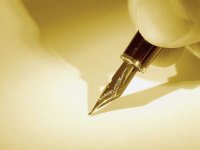








A fountain pen is a nib pen that contains an internal reservoir of water-based liquid ink. The pen draws ink from the reservoir, through a feed, to the nib and deposits it on paper via a combination of gravity and capillary action.
Filling the reservoir with ink may be achieved manually to transfer ink directly through the nib into the reservoir. Some pens employ removable reservoirs in the form of pre-filled ink cartridges. A fountain pen needs little or no pressure on the nib to write. World Fountain Pen Day is celebrated on the first Friday of November every year by the lovers of fountain pens.
History
The earliest historical record of a reservoir pen dates to the 10th century. In 973, Ma'?d al-Mu'izz, the caliph of the Maghreb, demanded a pen that would not stain his hands or clothes, and was provided with a pen that held ink in a reservoir and delivered it to the nib, which could be held upside-down without leaking, as recorded in Kitab al-Majalis wa 'l-musayarat, by Qadi al-Nu'man al-Tamimi (d. 974).No details of the construction or mechanism of operation of this pen are known, and no examples have survived.
That some form of pen with an ink reservoir was available in Europe in the 17th century is shown by contemporary references. In Deliciae Physico-Mathematicae (a 1636 magazine), German inventor Daniel Schwenter described a pen made from two quills. One quill served as a reservoir for ink inside the other quill. The ink was sealed inside the quill with cork. Ink was squeezed through a small hole to the writing point. In 1663 Samuel Pepys referred to a metal pen "to carry ink".Noted Maryland historian Hester Dorsey Richardson (1862–1933) documented a reference to "three silver fountain pens, worth 15 shillings" in England during the reign of Charles II, c. 1649–1685.By the early 18th century such pens were already commonly known as "fountain pens".Hester Dorsey Richardson also found a 1734 notation made by Robert Morris the elder in the ledger of the expenses of Robert Morris the younger, who was at the time in Philadelphia, for "one fountain pen".
In 1828 Josiah Mason improved a cheap, efficient slip-in nib in Birmingham, England, which could be added to a fountain pen and in 1830, with the invention of a new machine, William Joseph Gillott, William Mitchell,and James Stephen Perry devised a way to mass manufacture robust, cheap steel pen nibs. This boosted the Birmingham pen trade and by the 1850s, more than half the steel-nib pens manufactured in the world were made in Birmingham. Thousands of skilled craftsmen and -women were employed in the industry. Many new manufacturing techniques were perfected, enabling the city's factories to mass-produce their pens cheaply and efficiently. These were sold worldwide to many who previously could not afford to write, thus encouraging the development of education and literacy.
Progress in developing a reliable pen was slow until the mid-19th century, because of an imperfect understanding of the role that air pressure plays in the operation of pens and because most inks were highly corrosive and full of sedimentary inclusions. The Romanian inventor Petrache Poenaru received a French patent on May 25, 1827, for the invention of a fountain pen with a barrel made from a large swan quill.In 1848 American inventor Azel Storrs Lyman patented a pen with "a combined holder and nib".From the 1850s there was a steadily accelerating stream of fountain pen patents and pens in production. However, it was only after three key inventions were in place that the fountain pen became a widely popular writing instrument. Those were the iridium-tipped gold nib, hard rubber, and free-flowing ink.
The first fountain pens making use of all these key ingredients appeared in the 1850s. In the 1870s Duncan MacKinnon, a Canadian living in New York City, and Alonzo T. Cross of Providence, Rhode Island, created stylographic pens with a hollow, tubular nib and a wire acting as a valve. Stylographic pens are now used mostly for drafting and technical drawing but were very popular in the decade beginning in 1875. In the 1880s the era of the mass-produced fountain pen finally began. The dominant American producers in this pioneer era were Waterman, of New York City, and Wirt, based in Bloomsburg, Pennsylvania. Waterman soon outstripped Wirt, along with many companies that sprang up to fill the new and growing fountain pen market. Waterman remained the market leader until the early 1920s.